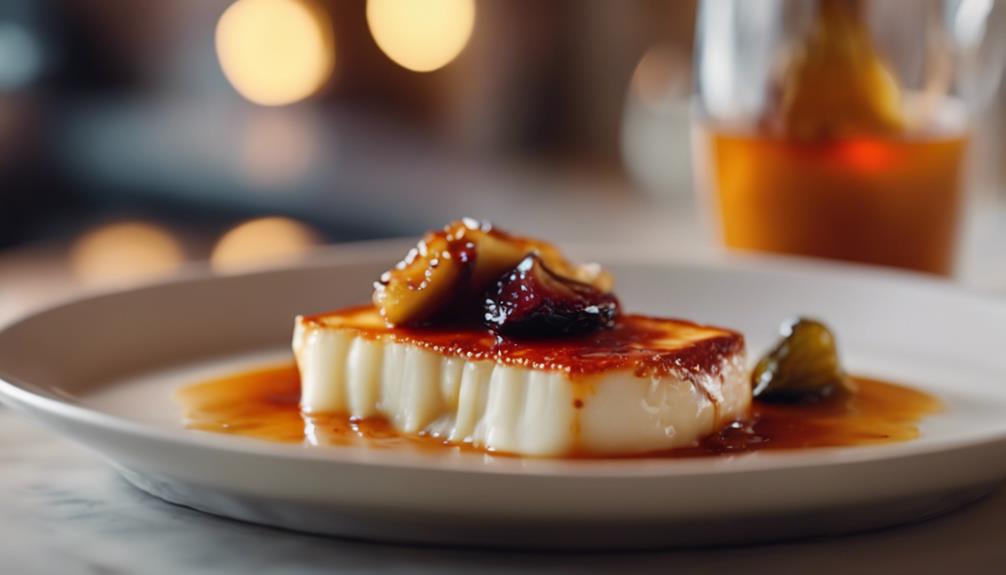Sous Vide Greek Saganaki With Fig Compote
Elevate your culinary skills with Sous Vide Greek Saganaki topped with decadent Fig Compote. Enhance the traditional tastes of Greece with this contemporary variation. The fig compote, imbued with star anise and pastis, brings a Provencal flair to your meal. Enjoy a flawless fusion of savory and sweet flavors. Immerse yourself in this inventive recipe to delight your taste buds!
What You Will Learn Here
- Sous vide method ensures precise cooking for tender cheese and figs.
- Fig compote with star anise and pastis adds a Provencal touch.
- Fusion of Greek saganaki with French-inspired compote for a unique dish.
- Balancing sweet figs with salty feta in a modern Greek twist.
- Elevates traditional saganaki with innovative flavors and cooking technique.
Origin of Saganaki Dish

Let's explore the intriguing origins of the beloved Saganaki dish – from its humble beginnings in traditional Greek cuisine to its evolution into a popular appetizer.
Discover the rich history behind Saganaki, how this iconic dish has been adapted over the years, and the cultural significance it holds in Greek culinary traditions.
Uncover the secrets of how this simple yet flavorful fried cheese dish has captured the hearts and taste buds of food enthusiasts worldwide.
Saganaki Dish History
The history of the Saganaki dish traces back to the culinary traditions of Greece, showcasing a delightful fusion of sizzling cheese and flavorful ingredients. This traditional Greek dish features fried cheese, often using varieties like feta or kefalotyri, creating a golden and crispy exterior that encases a gooey and savory center.
Served with a squeeze of lemon juice for a citrusy kick, Saganaki is a beloved appetizer or mezze in Greek cuisine. While the dish itself is simple, the combination of textures and flavors is what makes it stand out. Some modern variations even include a twist by adding ingredients like balsamic vinegar or fresh figs, elevating the classic dish to new heights of deliciousness.
Traditional Saganaki Origins
Tracing back through the culinary annals of Greece, the origins of the traditional Saganaki dish reveal an intriguing tale of sizzling cheese and flavorful traditions. The name 'saganaki' not only represents the dish itself but also the small frying pan in which it's expertly cooked to achieve that perfect golden crispiness.
The dish's roots can be traced back to the rich Greek culinary heritage, where it has become a beloved staple known for its indulgent flavors and warm, comforting appeal. Typically made with cheeses like feta, kefalotyri, or kasseri, saganaki is often served with a revitalizing squeeze of lemon, enhancing its savory profile.
For more insights into traditional Greek cuisine and recipes, feel free to reach out to us at our email address.
Evolution of Saganaki
Digging into the culinary transformation of saganaki reveals a mesmerizing journey through time, where the sizzle of fried cheese in a small pan has transcended mere sustenance to become a cherished emblem of Greek gastronomy.
The evolution of saganaki has seen traditional recipes embracing modern twists to cater to changing culinary trends. Chefs are experimenting with innovative flavor combinations, from incorporating honey and sesame seeds to infusing it with truffle oil or topping it with a zesty tomato salsa.
These contemporary adaptations breathe new life into the classic dish, appealing to a wider audience while still paying homage to its rich Greek heritage. Saganaki continues to evolve, blending tradition with creativity to delight food enthusiasts worldwide.
Feta and Honey Drizzle

Enhancing the saganaki with a drizzle of feta and honey blends salty and sweet flavors to create a harmonious taste experience. The feta and honey drizzle bring a perfect balance of sweet and savory notes to the dish, elevating its overall taste profile. Here's why this combination is a must-try:
- Flavor Contrast, Taste Balance: The contrast between the salty feta and the sweetness of the honey creates a delightful interplay of flavors on your palate.
- Sweet and Savory Combination: The marriage of sweet honey and tangy feta in the drizzle adds depth and complexity to the saganaki, making each bite a culinary delight.
- Richness Enhancement, Tangy Complement: Drizzling honey over the saganaki not only enhances the richness of the dish but also beautifully complements the tangy notes of the feta cheese, resulting in a well-rounded and satisfying taste experience.
Feta Saganaki Variations
When it comes to Feta saganaki variations, the possibilities are endless. From the classic Fried Feta Saganaki With Figs to the indulgent Fig and Honey Glaze, each variation offers a unique twist on this beloved dish.
Whether you're a fan of the traditional recipe or looking to experiment with new flavors, Feta saganaki variations are sure to delight your taste buds.
Fried Feta Saganaki With Figs
For a delectable twist on traditional Greek saganaki, try preparing Fried Feta Saganaki with Figs to experience a delightful fusion of flavors.
- Fig Pairing: The caramelized figs bring a subtle sweetness that complements the salty tang of the fried feta, creating a harmonious blend of tastes.
- Cheese Textures: The outer layer of crispy, golden-brown cheese gives way to a creamy, velvety interior, offering a satisfying contrast in textures with each bite.
- Sweet-Savory Balance: The fig compote not only adds a touch of sweetness but also helps strike a perfect balance between the savory richness of the cheese and the fruity notes of the figs, making each mouthful a symphony of flavors.
Fig and Honey Glaze
To elevate your Fried Feta Saganaki experience with a delightful twist, consider incorporating the luscious Fig and Honey Glaze for a burst of contrasting flavors and textures.
- The Fig and Honey Glaze adds a sticky and rich layer to the salty saganaki cheese, enhancing both the sweet and savory elements of the dish.
- The combination of figs and honey creates a unique flavor profile that balances out the dish, providing a delightful contrast.
- This variation of saganaki offers a sophisticated twist with the sweet and sticky fig and honey glaze, elevating the overall taste experience.
The Fig and Honey Glaze truly enhances the traditional saganaki, creating a harmonious blend of flavors that will leave your taste buds craving more.
Fig-Infused Feta Saganaki
Indulge in the exquisite flavors of Fig-Infused Feta Saganaki, a delectable Greek dish that marries the tangy creaminess of feta cheese with the luxurious sweetness of figs.
3 Reasons to Love Fig-Infused Feta Saganaki:
- Flavorful Combinations: The fig compote, with its caramelized fresh figs, sugar, and spices, creates a perfect sweet topping for the salty richness of the saganaki cheese.
- Culinary Creativity: This dish showcases innovative cheese pairing, combining the traditional saganaki with the unexpected sweetness of figs for a gourmet fusion.
- Gourmet Fusion: The sweet and savory blend in fig-infused feta saganaki offers a sophisticated twist on a classic dish, elevating it to a whole new level of culinary delight.
Serving Suggestions for Saganaki
When serving saganaki, consider selecting ideal platters that can showcase the dish's sizzling presentation.
Pairing saganaki with the right wines can elevate the flavors and create a harmonious dining experience.
Garnishing your saganaki with fresh herbs not only adds a burst of color but also enhances the overall taste profile.
Ideal Serving Platters
For a rustic touch to the presentation of your saganaki, consider serving it on a wooden cheese board. The natural charm of the wood complements the warm colors of the saganaki and fig compote.
If you're aiming for a more elegant look, a marble platter can provide a sophisticated backdrop, highlighting the golden hues of the dish.
For a modern and stylish presentation, opt for a slate serving platter, adding a contemporary touch to your table.
Alternatively, a ceramic platter with intricate designs can enhance the visual appeal of the saganaki and fig compote, making it a feast for both the taste buds and the eyes.
If you prefer a personalized and intimate dining experience, serving the saganaki on individual small plates is a great way to create a special atmosphere for your guests.
Pairing With Wines
To enhance your dining experience with saganaki, consider the ideal wine pairings that complement the flavors of this Greek dish. When pairing wines with saganaki, it is crucial to match the flavors and textures for a delightful experience. The salty and savory notes of saganaki can be beautifully complemented by white wines like Assyrtiko, Moschofilero, or a crisp Sauvignon Blanc. Alternatively, the fruity undertones in a Pinot Grigio or Chardonnay can balance out the dish's flavors. If you prefer red wine, opt for a light-bodied option such as Pinot Noir or Beaujolais. To balance the sweetness of the fig compote, consider a semi-sweet Riesling or a sparkling Prosecco. For an authentic Greek experience, explore Greek wines like Xinomavro or Agiorgitiko.
| White Wines | Red Wines |
|---|---|
| Assyrtiko | Pinot Noir |
| Moschofilero | Beaujolais |
| Sauvignon Blanc | |
| Pinot Grigio | |
| Chardonnay |
Garnishing With Herbs
Enhance the presentation of your saganaki by garnishing it with an array of fresh herbs, adding visual appeal and a burst of complementary flavors. Commonly used herbs like oregano, parsley, and thyme not only bring a pop of color but also enhance the overall taste experience.
The vibrant green hues of the herbs against the golden brown saganaki create an eye-catching contrast that signals freshness and culinary creativity. The aromatic nature of these herbs provides a delightful fragrance that complements the rich and savory saganaki cheese, elevating each bite with a harmonious blend of flavors.
Garnishing with herbs is a simple yet effective way to enhance both the visual appeal and taste profile of your saganaki dish.
Final Thoughts
In reflecting on this culinary journey with Sous Vide Greek Saganaki and Fig Compote, consider the harmonious blend of flavors and textures that elevate this dish to a truly memorable experience.
The final thoughts on this dish reveal a delightful marriage of culinary techniques and flavor combinations that showcase the versatility of fresh figs. The fig compote, infused with star anise and pastis, introduces a Provencal flair that adds a unique and aromatic twist to the overall dish.
The precision cooking method used for the fig compote guarantees a consistent and thorough cooking process, resulting in a rich and flavorful combination of butter, sugar, honey, and salt. By meticulously following the cooking directions, including vacuum sealing the ingredients and maintaining a precise temperature, you can create a thick and delicious fig compote that perfectly complements a variety of dishes.
This dish exemplifies how attention to detail in both technique and ingredient pairing can elevate a simple recipe into a culinary masterpiece.
Frequently Asked Questions
Can I Use a Different Type of Cheese Instead of Feta for This Dish?
If you're looking to swap out feta in your dish, consider cheeses like halloumi or kefalotyri. They offer similar salty tang and melt well. Experiment to find the flavor profile that suits your taste.
How Can I Make the Fig Compote Ahead of Time for This Recipe?
To make the fig compote ahead, try variations like adding citrus zest for brightness. Plan ahead for a flavorful twist by infusing spices like cinnamon or star anise. Pair with cheeses or charcuterie for a delectable treat.
Can I Substitute Fresh Figs for Dried Figs in the Compote?
Yes, you can swap fresh figs for dried ones in the compote, altering its texture and flavor profile. While dried figs offer a concentrated sweetness, fresh figs bring a juicier, lighter element to the dish, providing a delightful twist in your recipe.
What Other Dishes Would Pair Well With This Sous Vide Greek Saganaki?
For wine pairings, consider a crisp Sauvignon Blanc or a fruity Pinot Noir. Side dishes like a fresh Greek salad or roasted vegetables complement the saganaki. Appetizer options could include stuffed grape leaves or hummus with pita bread.
Can the Saganaki Be Made in Advance and Reheated Before Serving?
Yes, you can make the saganaki in advance. To reheat, use methods like oven baking or stovetop warming for best results. This time-saving tip allows you to prep ahead, ensuring a delicious dish without last-minute stress.
Conclusion
Indulge in the rich, creamy flavors of sous vide Greek saganaki with fig compote. The perfect balance of savory and sweet, this dish is sure to impress your taste buds.
With its origins steeped in tradition and endless variations to explore, saganaki offers a versatile and delicious dining experience.
Serve it up at your next gathering and watch as your guests savor every bite of this delectable dish. Bon appétit!











